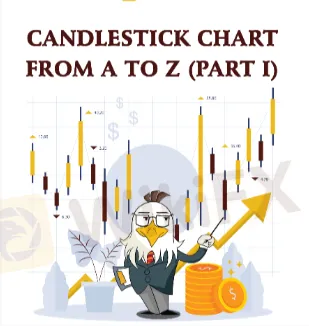简体中文
繁體中文
English
Pусский
日本語
ภาษาไทย
Tiếng Việt
Bahasa Indonesia
Español
हिन्दी
Filippiiniläinen
Français
Deutsch
Português
Türkçe
한국어
العربية
Candlestick Chart from A to Z (Part I)
Abstract:Japanese candlestick chart (Candlestick chart) is an analytical support tool used by the Japanese since ancient times to trade rice.
1. Concept
- Japanese candlestick chart (Candlestick chart) is an analytical support tool used by the Japanese since ancient times to trade rice.
- Mr. Steve Nison discovered this secret while working with brokerage firms in Japan. Later, he further researched and popularized this technique in the West. This technique became popular around the 90s of the 20th century.
2. A candle's structure
- Candle body: is composed of two information about the closing and opening prices.
• If the closing price is higher than the opening price, the body will be colored white (or usually green), representing a bullish period.
• If the closing price is lower than the opening price, the body will be colored black (or usually red), representing a bearish period.
- The shadow part: located at the ends of the body, composed of the highest and lowest price.
• With information about the highest price, the candlestick shadow will be above.
• With the lowest price information, the candlestick shadow will be below.

Disclaimer:
The views in this article only represent the author's personal views, and do not constitute investment advice on this platform. This platform does not guarantee the accuracy, completeness and timeliness of the information in the article, and will not be liable for any loss caused by the use of or reliance on the information in the article.
Read more

These Are How Millionaire Forex Traders Think and Act
It's no secret that in the world of trading, the most difficult thing is realization. Everyone can expect to be a successful trader, a trader who wins a lot of money, to a millionaire trader. But all this could be a dream if they didn't try to chase it.

How to Register Forex Trading, 5 Easy Steps to Follow
Foreign exchange has been developed and turned into something big in all of society. Not just office employees, but also students, kids in school, housewives, and even the unemployed.

Pip In Forex Trading, The Relation to Profitability
Pip or price interest point or percentage in point is a measurement tool associated with the smallest price movement any exchange rate makes. Usually, there is four decimal places used to quote currencies.

Euro Drops to 2-Decade Low on Recession Fears
Worries about how the European Central Bank will react also undermined sentiment after Germany's Bundesbank chairman Joachim Nagel lashed out at the ECB's plans to try and protect heavily indebted countries from sharp increases in lending rates.
WikiFX Broker
Latest News
The Withdrawal Trap: How Scam Brokers Lure Victims into Paying More
FCA to Investors: Think Twice Before Trusting These Brokers
Trump\s tariffs: How could they affect the UK and your money
Trump gambles it all on global tariffs he\s wanted for decades
TradingView Brings Live Market Charts to Telegram Users with New Mini App
Trump tariffs: How will India navigate a world on the brink of a trade war?
Interactive Brokers Launches Forecast Contracts in Canada for Market Predictions
IG Group Acquires Freetrade for £160M to Expand UK Investment Market
U.S. March ISM Manufacturing PMI Released
Should You Beware of Forex Trading Gurus?
Currency Calculator







